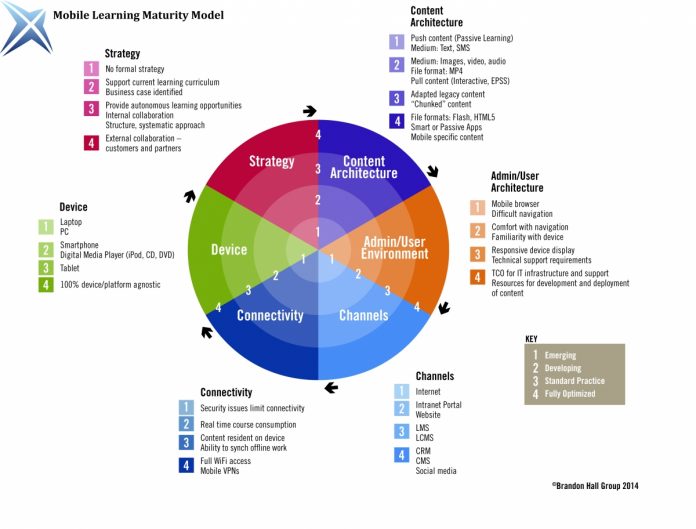
The use of mobile devices to accomplish all manner of tasks at work has become so ubiquitous and commonplace that it is surprising when you do not see an office full of people with their eyes glued to a handheld device of some sort. However, using these same devices within the context of enterprise learning is still considered somewhat of a novelty. According to Brandon Hall Group’s 2013 Mobile Learning Survey, 27 percent of organizations report there is absolutely no mobile interaction with learning. Among those companies that have delved into mobile learning, only 58 percent are doing anything beyond limited mobile Web access.
The challenge is where to begin.
Brandon Hall Group developed its Mobile Learning Maturity Model to give organizations perspective on where they are today in terms of using mobile devices for learning, and a roadmap for moving forward toward a more mature approach. The model was developed based on the resident expertise of Brandon Halll Group analysts along with results of our 2013 Mobile Learning Survey.
The model is built upon four levels of maturity—Emerging, Developing, Standardized, or Full Optimized—across six different areas of mobile learning focus:
- Strategy
- Content Architecture
- Admin/User Environment
- Channels
- Connectivity
- Devices
Not all organizations will be operating at the same level for each area. An organization could reasonably find itself at a different maturity level in any the different categories. The ideal model for any given organization depends on a wide variety of factors, including culture, learning audience, and the overall learning goals. By examining how your organization compares with the Brandon Hall Group’s Mobile Learning Maturity Model, it becomes clearer which steps to take to move closer to a fully optimized mobile learning strategy.
Figure 1: Brandon Hall Group’s High-Performance Mobile Learning Maturity Model (graphic also attached for download below)

Strategy
Level 1, Emerging: Many organizations approach mobile learning as simply a new technology add-on to the current learning process. On the surface, there is nothing wrong with this state of being, but if organizations want to take full advantage of the potential of mobile learning, they need to move forward.
Level 2, Developing: In this stage, organizations are beginning to recognize the business case for mobile learning and are supporting learner access to content via mobile devices. Although there is not really any mobile-specific content, organizations at this level are removing roadblocks that may have prevented mobile access in the past.
Level 3, Standard Practice: At this stage, companies have developed a formal strategy for mobile learning. Along with the strategy comes dedicated processes and infrastructure to enable mobile learning and make it more effective. Our research shows that organizations with a strategy in place find their material to be far more effective.
Level 4, Full Optimized: At this level, organizations are pushing learning outside of the enterprise to other entities all along the supply chain. These are companies that are delivering mobile how-to videos to their customers or moment-of-need sales support to their franchisees or distributors.
Takeaways: Even if the mobile learning strategy is not fully developed, it can help provide guidance and focus. If it fits better with your organization’s structure and culture, it can be enough to have a robust mobile piece to the overall learning strategy. In the end, it’s about using tools to meet learning objectives that ultimately help reach business goals.
Content Architecture
Level 1, Emerging: At this level, what little mobile interaction exists typically takes the form of “push” content. This is the most basic form of passive learning, where bits of information are pushed out to learners en masse, through a simple SMS or text messaging system.
Level 2, Developing: As organizations become more comfortable with mobile learning, they branch out into different media and formats and allow learners to “pull” content to their devices. A perfect example is the use of podcasts. Another place organizations begin experimenting with mobile is within an electronic performance support system (EPSS).
Level 3, Standard Practice: Recognizing that people use their phones and tablets differently than their PC or laptop is the key here. It may seem like a commonsense concept, but when it comes to mobile learning, organizations are still struggling with this. At this level, content becomes much more mobile specific. For instance, there is more use or experimentation with short videos and quick courselets.
Level 4, Fully Optimized: Thinking mobile is part of the content development process at this highest level of maturity. Content is being designed for mobile first, in a way that complements other, more traditional deliveries. There will be heavy use of HTML5 and responsive Web design, which allows Web objects to display and interact properly regardless of device.
Takeaways: You cannot approach mobile delivery from a traditional e-learning mindset. Instead, think smaller, simpler, and snappier. Break down existing content into smaller chunks. When creating new content, think mobile out of the gate and see what can be designed to go mobile first. Video is a great place to start.
Admin/User Environment
Level 1, Emerging: At this level, a mobile environment for learning has not been created yet, so learners who do venture out on their own and interact with learning on their mobile device are typically disappointed. This can translate into a misinterpretation of the level of interest in mobile learning, where feedback from learners is that mobile learning is not effective.
Level 2, Developing: At this stage, organizations recognize that a mobile environment needs to be developed around the unique features of mobile devices and what learners expect from a mobile experience.
Level 3, Standard Practice: Organizations have dedicated at least some IT infrastructure and support to mobile initiatives. This ensures that admins have a support system in place when they encounter challenges related to mobile learning.
Level 4, Fully Optimized: Here learners are presented with an uninterrupted experience, regardless of where they are or what device they may be using. People can get up from their desks at the end of the day, open the app on their phone, and pick up right where they left off.
Takeaways: The mobile environment should reflect these differences: Easy to read, more graphics than text (although not too graphic intensive), and a focus on finger swipes rather than point and click.
Channels
Level 1, Emerging: The main characteristic here is that there really are no channels through which learners can connect to material. Many employees figure out ways to connect on their own, either out of curiosity or necessity.
Level 2, Developing: Allowing access to the company’s intranet via mobile device is a clear signal that the organization is ready to become mobile enabled. Making sure that learning-related Websites have mobile friendly versions is another good place to start. Even if your organization never goes any further than this, providing mobile-friendly access to the current learning environment can improve the learner experience greatly.
Level 3, Standard Practice: At this level, organizations would have a learning management system (LMS) with a mobile-ready component. But our research shows that only 11 percent of respondents are at that point. If a company is using an LMS, making sure there is complete mobile compatibility is the lynchpin to a successful mobile strategy.
Level 4, Fully Optimized: Once there is relatively unfettered access to learning via mobile devices, there are opportunities to expand the potential for mobile. For other enterprise systems that are integrated with learning, such as customer relationship management (CRM) or Human Resource Information Systems (HRIS), expanding mobile connectivity to these areas can help leverage these integrations.
Takeaways: If your company uses an LMS, dig into the mobile capabilities. Many providers say they are mobile-ready, but in reality, they simply are allowing access through a mobile browser.
Connectivity
Level 1, Emerging: One of the first hurdles an organization comes across when looking into mobile learning is security. IT departments are typically very touchy about access to certain systems via devices they do not control. Without a business case for mobile, it can be difficult to get the infrastructure in place to enable truly mobile learning.
Level 2, Developing: A good first step is to allow for real-time interaction with course material. Keeping it Web-based at this stage keeps the security issue from being insurmountable and allows for learner-initiated mobile connections.
Level 3, Standard Practice: With a history of mobile Web-enabled content under its belt, an organization can begin experimenting with downloadable content.
Level 4, Fully Optimized: Organizations with a sophisticated approach to mobile have Wi-Fi networks available on premises for users to connect. This eliminates capacity issues, as well as bandwidth concerns. That’s not to say security concerns do not still exist. But Wi-Fi access points can be controlled and managed based on various permissions, preventing unfettered access to all of the company’s systems.
Takeaways: Your IT team can help identify any concerns before they become actualized and lay out scenarios for eliminating them. This also will give the strategy team an honest picture of what it will take to deliver on the mobile strategy.
Device
Level 1, Emerging: Once the iPhone debuted in 2007, there was a real debate about whether Apple or Android would end up being the technology of record, much like the battle between VHS and Betamax or the one between HDDVD and Blu-Ray. Even though the market has settled this with a resounding “everyone wins,” organizations have been slow on their feet to recognize a world where multiple devices are at their disposal. So companies that are making their first foray into mobile learning are even today somewhat flummoxed by the device dilemma.
Level 2, Developing: Almost 80 percent of organizations say they issue some sort of device to at least a segment of their employee population. The biggest challenges with issuing devices is that people generally already have a device, and it’s one they chose and like to use. To saddle them with a second device they may not be comfortable using can be counterproductive.
Level 3, Standard Practice: A more mature mobile learning culture can incorporate company-issued devices, but it also will accommodate other devices. At this stage, smart phones are not the only devices in play. Tablets are becoming more prevalent every day, and organizations should be aware of the needs of learners who prefer using them.
Level 4, Fully Optimized: In a truly mobile environment, the device almost becomes a non-issue. The ability to deploy to almost any device already exists; it’s simply a question of what the requirements for your particular learning audience are.
Takeaways: A mature mobile strategy will have some flexibility around devices and set up parameters for a BYOD- (bring your own device) friendly environment. Responsive Web design and platform-agnostic app design are necessary to make sure everyone’s needs can be met.
David Wentworth is senior learning analyst for Brandon Hall Group, an independent human capital management (HCM) research and advisory services firm. BHG provides insights around Learning and Development, Talent Management, Leadership Development, Talent Acquisition and Human Resources.




